Physical Address
304 North Cardinal St.
Dorchester Center, MA 02124
Four patients with this disorder were described by Smith and colleagues in 1964. Tint and colleagues in 1993 identified an abnormality in cholesterol biosynthesis in patients with this disorder that appears to explain much of the clinical phenotype.
The incidence of Smith-Lemli-Opitz syndrome (SLOS) in the United States is estimated at 2 in 100,000.
Growth. Moderately small at birth, with subsequent failure to thrive; final height between 143 and 170 cm. Low muscle mass.
Performance. Moderate to severe intellectual disability, with variable altered muscle tone; approximately 10% of biochemically diagnosed cases have intelligence quotients (IQs) between 50 and 70. A few cases have had IQs in the normal range. Close to 50% have a diagnosis of autism spectrum disorders and have some aggressive behaviors.
Craniofacial. Microcephaly with narrow frontal area, auricles slanted or low-set, ptosis of eyelids, inner epicanthal folds, strabismus, short nose, broad nasal tip with anteverted nostrils, broad maxillary secondary alveolar ridges, micrognathia.
Limb. Simian crease; high frequency of digital whorl dermal ridge patterning; “Y-shaped” syndactyly of second and third toes, sometimes bony and involving metatarsals; short, proximally placed thumb; postaxial polydactyly of hand and, less often, of feet.
Genitourinary. Genital abnormalities (70%), including hypospadias, cryptorchidism, micropenis, hypoplastic scrotum, bifid scrotum, and microurethra; upper tract anomalies (57%), including ureteropelvic junction obstruction, hydronephrosis, renal cystic dysplasia, renal duplication, renal agenesis, and reflux.
Cardiac. Defect in 50%, particularly endocardial cushion defect, hypoplastic left heart, atrial septal defect, patent ductus arteriosus, and membranous ventricular septal defect. Pulmonary vein stenosis, sometimes fatal.
Central and Peripheral Nervous Systems. Seizures; abnormal electroencephalogram (EEG); demyelination found in cerebral hemispheres, cranial nerves, and peripheral nerves; enlarged ventricles; large cavum septum pellucidum, agenesis or dysgenesis of corpus callosum; cerebellar hypoplasia; holoprosencephaly (5%).
Optic. Cataract, sclerosis of lateral geniculate bodies, lack of visual following, opsoclonus, nystagmus, sclerocornea, iris coloboma, heterochromia iridis, posterior synechiae, glaucoma, optic atrophy, microphthalmia.
Limb. Flexed fingers, asymmetrically short finger(s), radial agenesis, clinodactyly, camptodactyly, ectrodactyly, short first toes, metatarsus adductus, vertical talus, dislocation of hip.
Other . Ocular hypertelorism, absent lacrimal puncta, cleft palate, macrostomia, microglossia, bifid tongue, small larynx and vocal cords, sensorineural hearing loss, abnormal pulmonary lobation, hypoplasia of thymus, hypothyroidism, hypoparathyroidism, adrenal enlargement, adrenal insufficiency requiring steroids in severe cases, elevated 25OH vitamin D levels, inguinal hernia, hepatic dysfunction, pancreatic islet cell hyperplasia, deep sacral dimple, rectal atresia, pyloric stenosis, gallbladder aplasia, cholestatic liver disease, intestinal malrotation, diaphragmatic hernia, anal stenosis, Hirschsprung disease, pit anterior to anus, unusually blond hair, short neck.
Many of these babies are born in a breech presentation. Stillbirth and early neonatal death are not uncommon. Feeding difficulty and vomiting are frequent problems in early infancy. Oral tactile defensiveness and failure to progress to textured food are common and result in the need for nasogastric tube feeding in 50% of these babies. Gastroesophageal reflux is common because of a small stomach, intestinal dysmotility, and milk or soy protein allergy. Of those who survive, 20% die during the first year. Death appeared to be related to pneumonia in most of them, one of whom had a hemorrhagic necrotizing pneumonia with varicella, suggesting an impaired immune response. Irritable behavior with shrill screaming may pose a problem during infancy. Muscle tone, which may be hypotonic in early infancy, tends to become hypertonic with time. Diminished amount of sleep is common in early infancy. The degree of cognitive impairment is usually moderate to severe. However, affected children are sociable, have better receptive than expressive language, and may be mechanically adept. Behavioral characteristics of autism, self-injurious and aggressive behavior, and forceful backward arching are common. Painful and itchy photosensitivity is reported by the majority of patients with SLOS. Although dietary cholesterol supplementation has been used frequently to treat children with this syndrome, the only randomized clinical trial of behavioral effects of supplementation showed no difference between treatment and placebo groups, and no increase in cerebrospinal fluid cholesterol levels was seen. However, improved growth, improved tone and earlier ambulation, increased nerve conduction velocity, developmental cognitive and behavioral changes, and reduced photosensitivity have been noted in some.
This disorder has an autosomal recessive inheritance pattern. A severe defect in cholesterol biosynthesis has been identified leading to abnormally low plasma cholesterol levels and elevated concentrations of the cholesterol precursor 7-dehydrocholesterol, the result of a deficiency of 7-dehydrocholesterol reductase (DHCR7). The DHCR7 gene is localized to chromosome 11q12-13. Cholesterol is vitally important in normal development through its contribution to the cell membrane and outer mitochondrial membrane as well as its role in steroid, bile acid, and vitamin D metabolism, and in myelination of the nervous system. Its relative deficiency explains many of the variable features of this disorder. Cholesterol levels are low in 90% of cases. At present, only a chromatographic assay is suitable for measuring DHCR7.
Prenatal diagnosis has been accomplished successfully on the basis of an elevated DHCR7 in amniotic fluid. One of the earliest signs of an affected fetus is an abnormally low maternal serum level of unconjugated estriol on maternal triple screen. Direct measurement of sterol composition of chorionic villi at 10 weeks’ gestation is also reliable.
It is now recognized that the spectrum of defects seen in children with Smith-Lemli-Opitz syndrome is extremely broad. Severely affected patients die in the perinatal period with multiple structural defects, whereas much more mildly affected patients have minor structural anomalies with the characteristic behavioral and learning problems. All patients have a typical craniofacial pattern profile, which includes small skull size, decreased head length and width, narrow forehead, decreased facial depth, flat face, short nose with anteverted nares, and normal width of jaw with retro- or micrognathia. Plasma cholesterol concentration correlates with the degree of severity. Smith-Lemli-Opitz syndrome carrier frequency is 1% to 3%. Comparing predicted birth incidence with that observed in published literature suggests that approximately 42% to 88% of affected conceptuses experience prenatal demise. SLOS diagnosis should be considered in the differential diagnosis of fetal demise.
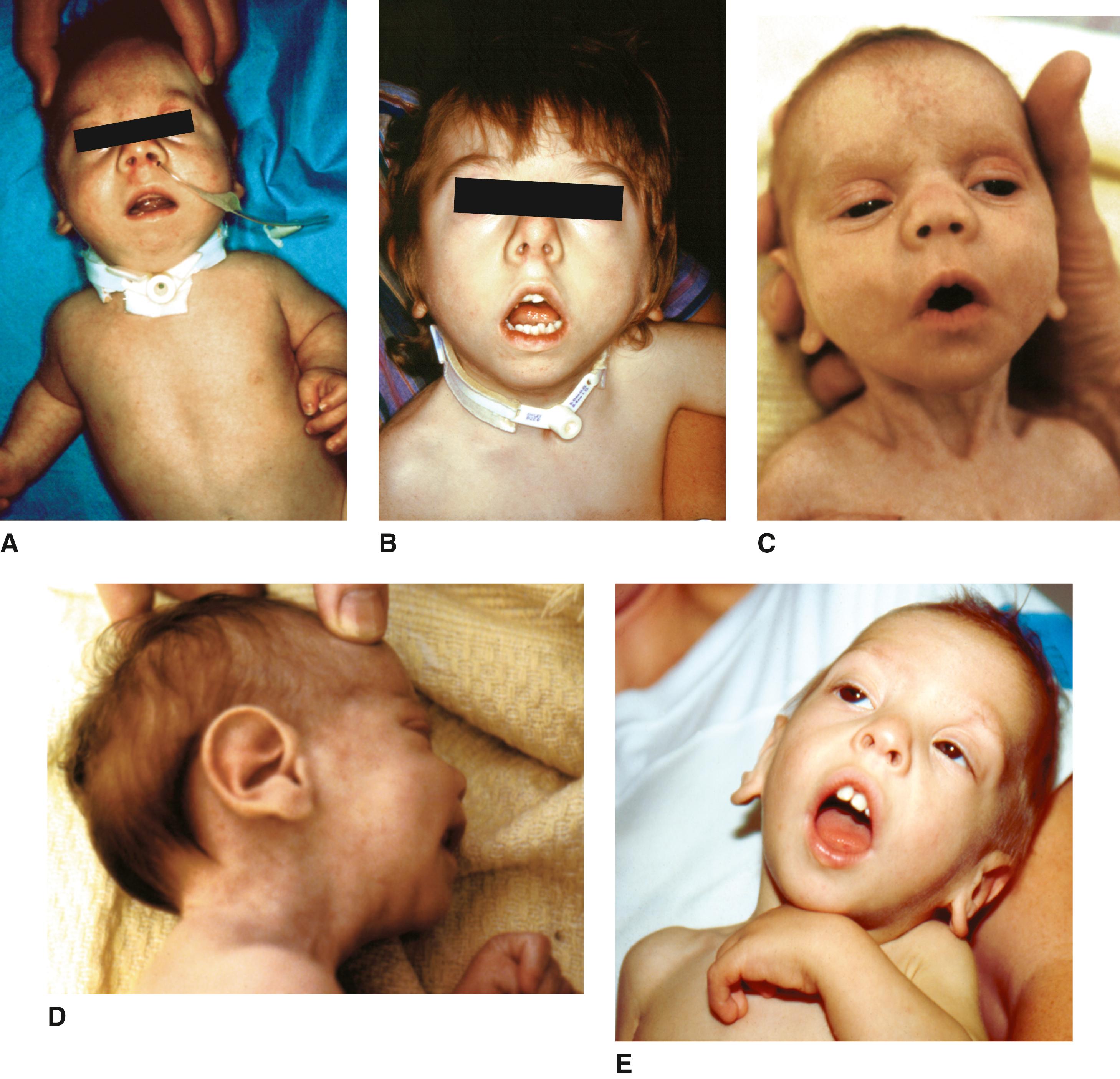
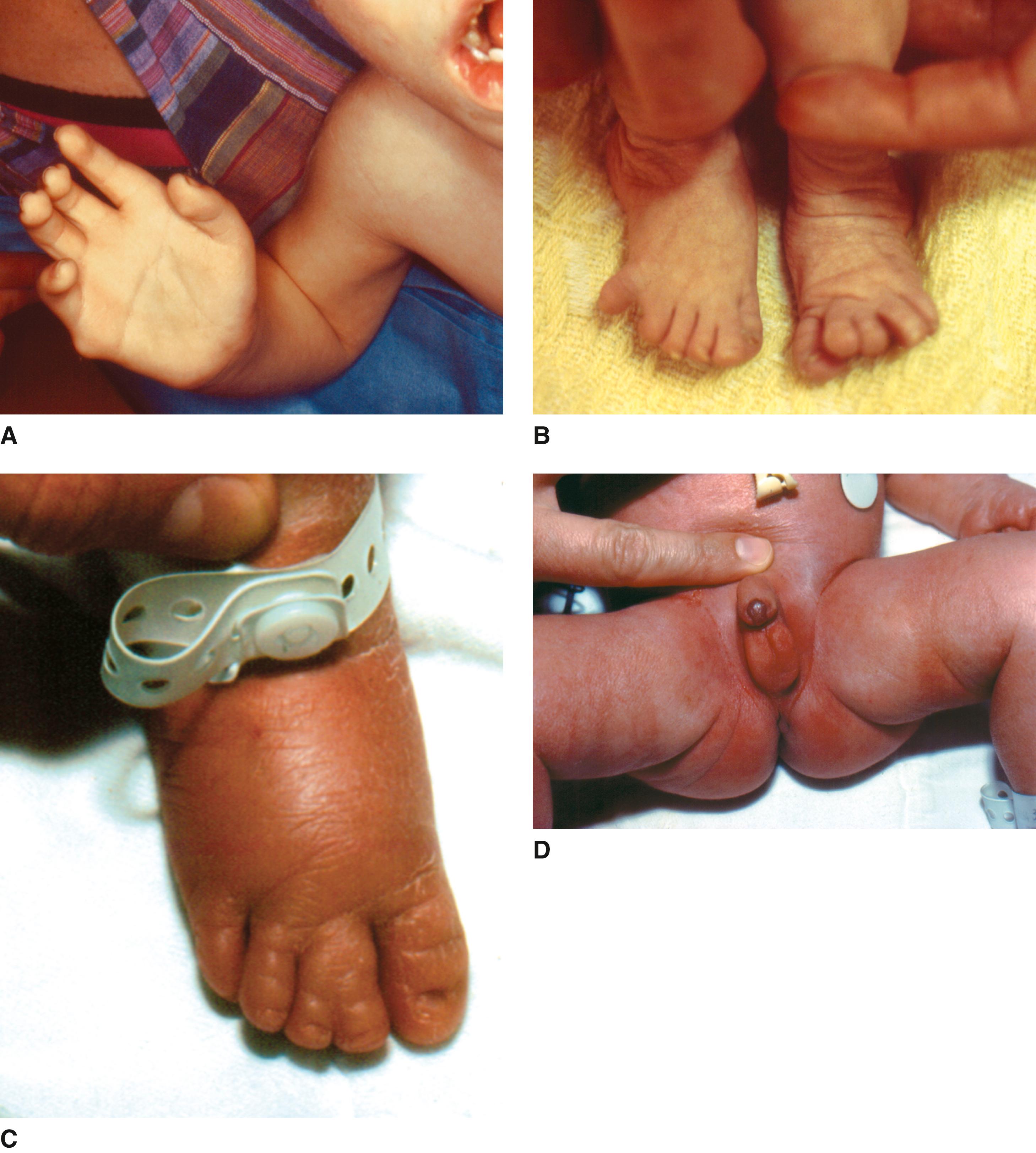
Initially reported in 1981 by Niikawa and colleagues and by Kuroki and colleagues in 10 unrelated Japanese children, this disorder has now been reported in more than 400 patients, many of them non-Japanese. Because of the facial resemblance of affected individuals to the make-up of actors in Kabuki, the traditional Japanese theater, this disorder has been referred to as the Kabuki syndrome.
Growth. Postnatal growth deficiency, with onset usually occurring in the first year, becomes more marked with increasing age; mean height in children 12 months or older was –2.3 SD.
Performance. Mean developmental quotient in infants and children is 52, and in older patients, mean IQ is 57; severe intellectual disability is uncommon; IQ equal to or greater than 80 in 12%, completely normal intelligence can be present; hypotonia; autism spectrum disorder features.
Craniofacial. Long palpebral fissures with eversion of the lateral portion of the lower eyelid, ptosis, arced and broad eyebrows with sparse lateral third, blue sclera, strabismus, epicanthal folds, short columella, large protuberant ears, preauricular pit, cleft palate, tooth abnormalities, open mouth with tented upper lip giving myopathic appearance.
Skeletal. Anomalies in 88%, including short, incurved fifth finger secondary to short fourth and fifth metacarpals; short middle phalanges; brachydactyly; rib anomalies; vertebral anomaly; hip dislocation; scoliosis, kyphosis, or both.
Cardiac. Defects occur in approximately 50% of patients and include malformations associated with altered hemodynamics such as coarctation of the aorta, bicuspid aortic valve, mitral valve prolapse, membranous ventricular septal defect, pulmonary, aortic, and mitral valve stenosis as well as tetralogy of Fallot, single ventricle with common atrium, double outlet right ventricle, and transposition of great vessels.
Other. Joint hyperextensibility (74%); persistent fetal finger pad (96%); excess digital ulnar loops; renal anomalies, urinary tract anomalies, or both (28%); hearing loss (32%).
Microcephaly; craniosynostosis; polymicrogyria; subarachnoid cyst; hydrocephalus secondary to aqueductal stenosis; other anatomic and functional brain abnormalities; autistic behavior; premature graying of hair; vitiligo; cleft lip; lower lip pits; Mondini dysplasias and ossicular anomalies; microtia; short nasal septum; broad nasal root; long eyelashes; preauricular pit; cutaneous syndactyly; nail hypoplasia; cryptorchidism; micropenis; delayed puberty; imperforate anus; umbilical and inguinal hernias; malrotation of colon; premature thelarche; precocious puberty; obesity; seizures; pectus excavatum; diaphragmatic hernia, eventration, or both; biliary atresia; stenosis of bronchial tree; growth hormone deficiency; predisposition to neoplasia.
A definitive diagnosis can be made in an individual of any age with a history of infantile hypotonia, developmental delay and/or intellectual disability, and one or both of the following major criteria: (1) a pathogenic or likely pathogenic variant in KMT2D or KDM6A ; and (2) typical dysmorphic features (long palpebral fissures with eversion of the lateral third of the lower eyelid; arched and broad eyebrows with the lateral third displaying notching or sparseness; short columella with depressed nasal tip; large, prominent or cupped ears; and persistent fingertip pads).
Although many of the characteristic facial features are present in neonates, the features become more obvious with age. Severe feeding problems are common. Congenital hyperinsulinism can occur. Susceptibility to infection, particularly otitis media, upper respiratory tract, and pneumonia, is common, and decreased levels of IgA, IgG, and IgM have been documented not infrequently. Autoimmune disorders are also more frequent. Obesity often occurs at adolescence. Delays in speech and language acquisition with articulation errors are common. A number of malignancies have been reported in Kabuki syndrome. Whether Kabuki syndrome really predisposes to cancer remains uncertain.
Approximately 60% of cases are caused by mutations in the mixed lineage leukemia 2 (MLL2) gene. Now known as KMT2D , it encodes proteins involved in histone modification. Nearly all patients with the most typical Kabuki syndrome facies have a pathologic KMT2D mutation. Mutations, partial or complete deletions of KDM6A , encoding a histone demethylase that interacts with KMT2D are found in 10% to 20% of diagnosed patients.
More recently additional genes involved in a minority of patients with Kabuki syndrome have been identified, including the RAP1A , RAP1B , and HNRNPK genes, which are associated with a Kabuki-like phenotype with nodular heterotopia. The phenotype associated to these genes is less specific of Kabuki syndrome.
A specific epigenetic signature enabled 100% sensitive and specific identification of individuals with Kabuki syndrome in a large series.
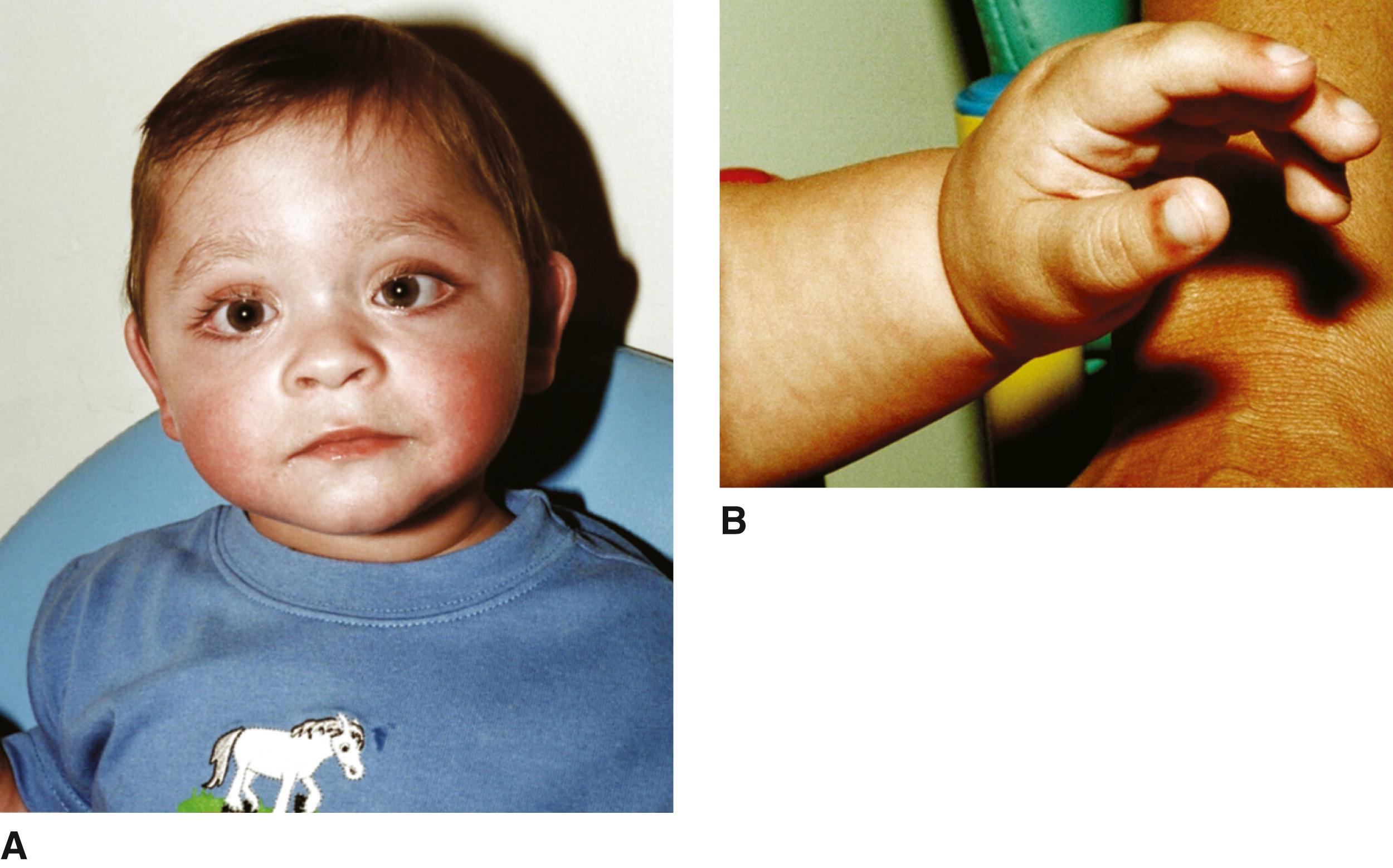
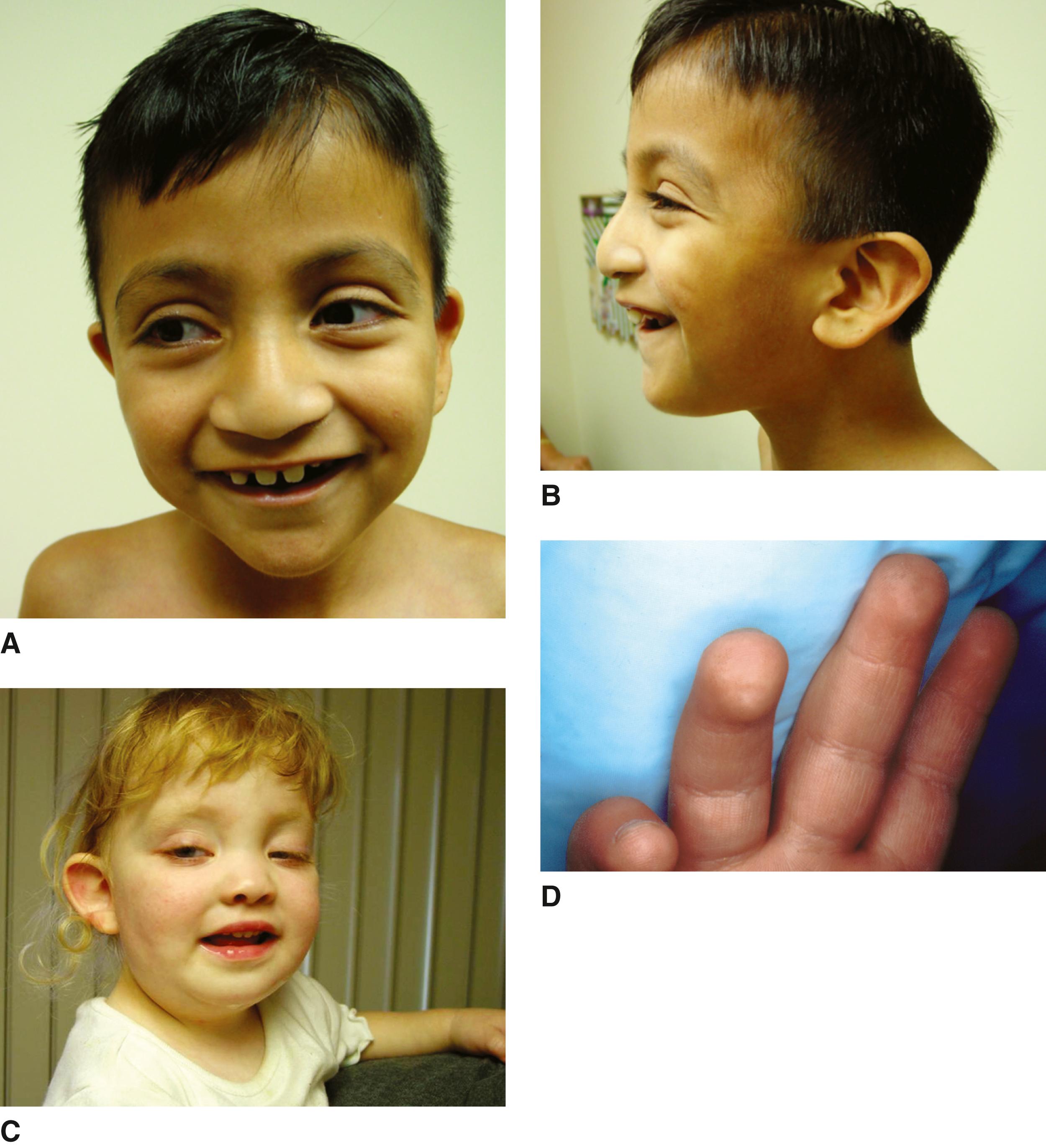
The first two cases of this rare intellectual disability disorder were reported in 2015 using the online tool, GeneMatcher, to connect clinicians following patients with similar phenotypes in whom de novo mutations in genes of unknown clinical significance were identified. To date 12 patients have been reported, including 3 with deletions that include HNRNPK .
Growth. Normal birth size (occasionally large), feeding issues, failure to thrive, postnatal growth deficiency, Marfanoid body habitus in older individuals.
Development. Hypotonia in infancy and beyond, poor neonatal transition, moderate to severe global developmental delay, good social performance, lax joints suggesting connective tissue abnormality, mixed conductive and sensorineural hearing loss, attention deficit–hyperactivity disorder.
Craniofacial. Craniosynostosis (metopic, sagittal), bitemporal narrowing, mildly coarse facies (not progressive), long face, proptotic eyes, downslanting palpebral fissures, long palpebral fissures, ptosis, ectropion of lower eyelids, medial eyebrow flare, sparse or broad lateral eyebrows, broad nasal root, hypoplastic or notched alae nasi, bifid nasal tip, poorly defined philtrum, wide downturned mouth, thin upper lip, malocclusion with open bite (older individuals), high arched palate, cleft palate.
Eyes. Megalocornea, lagophthalmos, optic nerve pit, coloboma optic disc, strabismus, nystagmus.
Ears. Thick helices, protuberant.
Neck. Loose nuchal skin, thick wrinkled skin.
Cardiac. Septal defects, bicuspid aortic valve, branched pulmonic stenosis, patent ductus arteriosus (PDA).
Intestinal. Anal atresia, gastrointestinal dysmo-tility, gastroesophageal reflux, malrotation.
Genitourinary. Cryptorchidism, hydronephrosis, vesicoureteral reflux, neurogenic bladder, UPJ obstruction.
Musculoskeletal. Scoliosis, segmentation and fusion defects, extra lumbar vertebrae, pectus excavatum.
Extremities. Slender fingers, hip dysplasia, coxa valga, planovalgus, postaxial polydactyly, prominent fetal pads, deep palmar and plantar creases.
Imaging. Nodular heterotopia, hypomyelination (brain), prominent vasculature (brain), agenesis of corpus callosum, pineal cyst, Chiari malformation, hydronephrosis, syringomyelia, osteoporosis.
Prenatal Findings. Increased nuchal translucency, nuchal thickening, cystic hygroma, two vessel cord, renal pyelectasis, ventriculomegaly, agenesis of corpus callosum, cardiac septal defects, pericardial effusions.
Microcephaly, seizures, auditory neuropathy, nasal sinus tract, midline groove of tongue, missing teeth, preauricular tag/pit, inverted nipples, branchial cyst, coarctation of aorta, prune belly sequence, cystic kidneys, tethered cord, talipes deformities, hypoplastic nails, early osteoporosis, thyroiditis, hypothyroidism.
Intellectual disability may be significant. Most children have learned to walk, but expressive language is typically quite impaired. Social adaptation is good. Regression has not been described. Postnatal growth deficiency is common but not invariable. One patient developed hyperphagia. One severely affected girl with a deletion died in early infancy of acute and chronic respiratory issues. A second child with a loss of function mutation died of complications of chronic renal failure. Obstructive sleep apnea has been reported but not systematically evaluated in these patients.
This syndrome is caused by deletion or loss of function variants in the heterogeneous nuclear ribonucleoprotein K gene ( KNRNPK ), a nucleic acid binding protein with roles in chromatin remodeling, transcription, translation, RNA splicing and stability, and signal transduction. All cases to date have been sporadic events. No familial recurrences have been reported.
Many of the published cases were first clinically diagnosed with Kabuki syndrome until exome sequencing excluded the Kabuki genes and identified the mutation in HNRNPK . Au-Kline syndrome causes a longer facial structure and is more commonly associated with craniosynostosis and significant genitourinary anomalies. Deletions including 9q21 that include HNRNPK produce an overlapping but more severe phenotype.
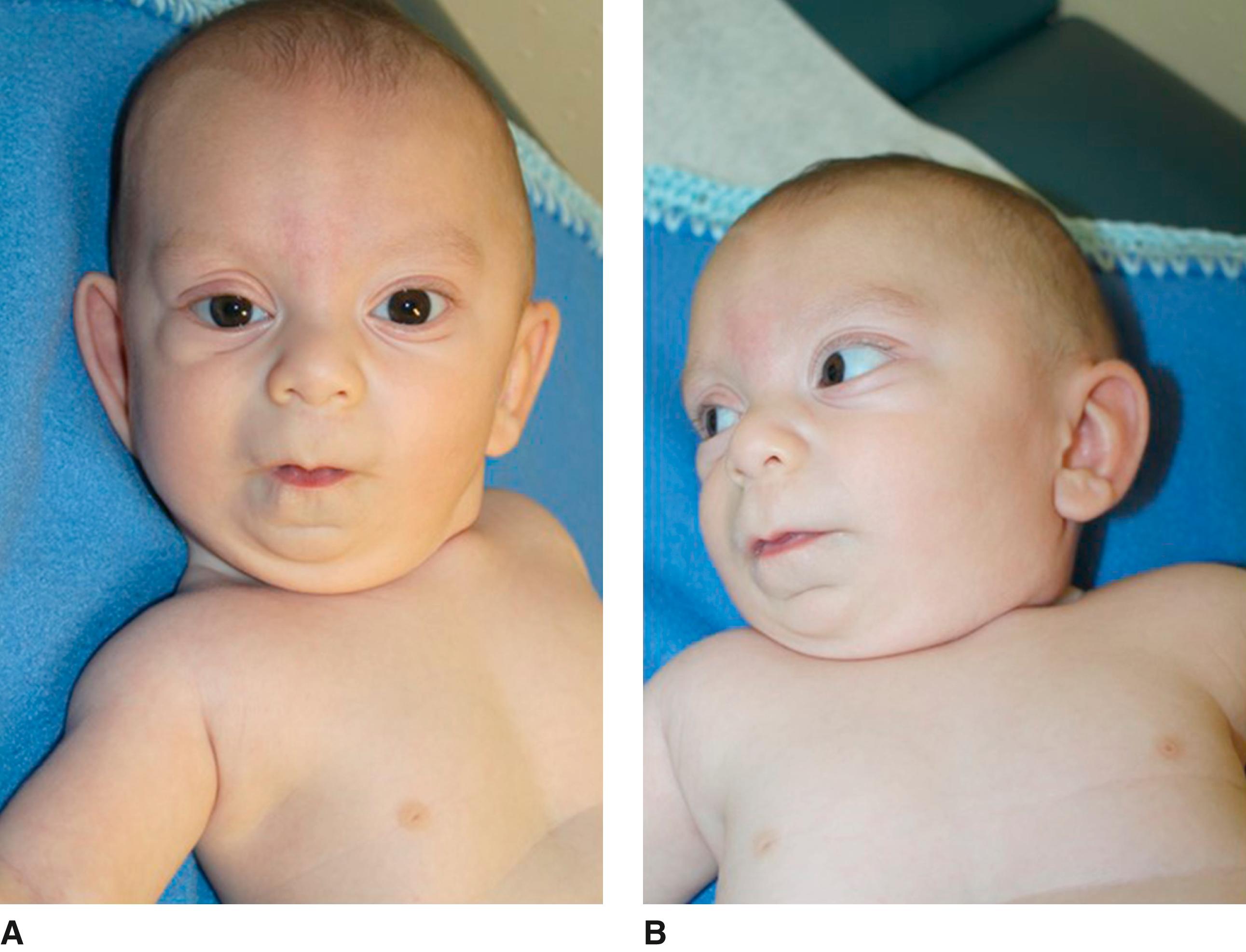
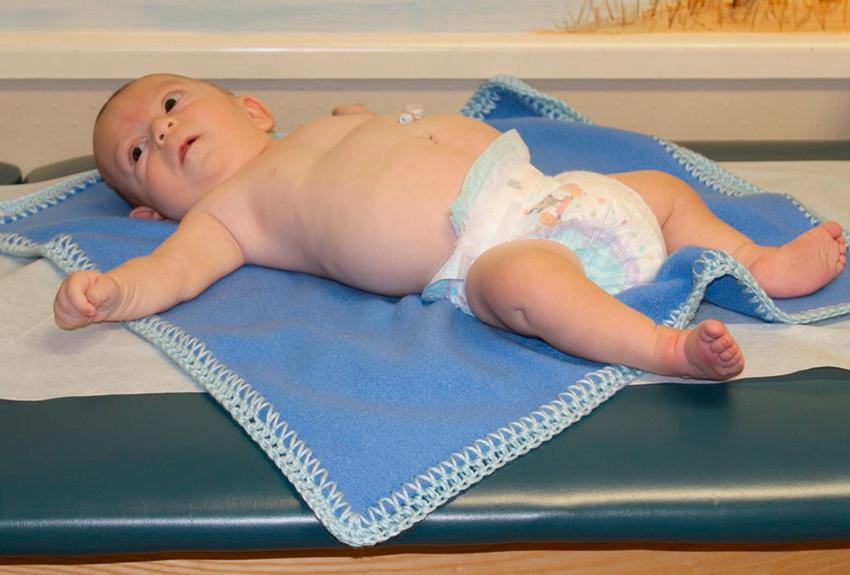
In 1961, Williams and colleagues described this disorder in four unrelated children with intellectual disability, an unusual facies, and supravalvular aortic stenosis. The disorder has a prevalence close to 1 in 10,000. Hypercalcemia has been an infrequent finding; cardiovascular anomalies, including supravalvular aortic stenosis, occur in 75% of cases. The facial features and the behavioral phenotype are very characteristic and recognizable.
Features vary from among the following:
Growth. Mild prenatal growth deficiency, postnatal growth rate approximately 75% of normal, mild microcephaly.
Performance and Neurologic. Average IQ close to 60, with a range from 41 to 80; friendly, loquacious personality, avid for socialization, asymmetric cognitive profile, level of general language ability is much greater than general cognitive ability, visuospatial skills are very impaired in childhood, anxiety, hoarse voice, hypersensitivity to sound, hyperactive deep tendon reflexes and poor coordination; hypotonia, mild spasticity manifest by tight heel cords, toe walking.
Facies. Periorbital fullness of subcutaneous tissues, blue eyes, stellate pattern in the iris, medial eyebrow flare, depressed nasal bridge, epicanthal folds, anteverted nares, long philtrum, full cheeks and full prominent lips with wide and open mouth.
Limb. Fifth finger clinodactyly, hypoplastic nails, hallux valgus.
Cardiovascular. Supravalvular aortic stenosis most frequent, peripheral pulmonary artery stenosis, pulmonic valvular stenosis, ventricular and atrial septal defect, multiple discrete or extensive vascular narrowings, including renal artery stenosis, coronary artery stenosis, hypoplasia or coarctation of the aorta, midaortic syndrome and other arterial stenosis, which may be progressive. Hypertension with increased arterial rigidity.
Dentition. Small separated teeth, partial anodontia, enamel hypoplasia, dental crowding, malocclusion.
Musculoskeletal. Joint hypermobility, contractures, scoliosis, kyphosis, lordosis, extra sacral crease.
Urinary. Renal anomalies, asymmetry in kidney size, small solitary or pelvic kidney, bladder diverticula, urethral stenosis, vesicoureteral reflux. Nephrocalcinosis secondary to hypercalcemia.
Other. Soft lax skin, premature gray hair.
Ocular hypotelorism, short palpebral fissures, amblyopia, strabismus, refractive errors, tortuosity of retinal vessels, high-frequency sensorineural hearing loss, vocal cord paralysis, malar hypoplasia, radioulnar synostosis, small penis, pectus excavatum, inguinal or umbilical hernia, colon diverticula, rectal prolapse, Chiari type I malformation, mucinous cystadenoma of ovary, portal hypertension, celiac disease, hypercalcemia, hypothyroidism, diabetes mellitus, obesity, early puberty.
Become a Clinical Tree membership for Full access and enjoy Unlimited articles
If you are a member. Log in here